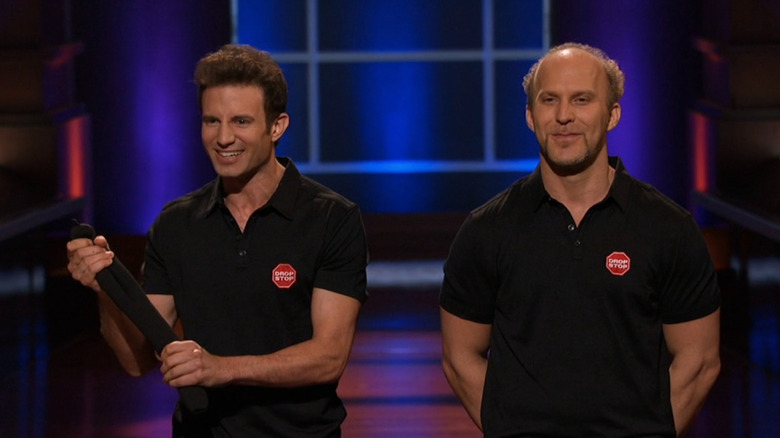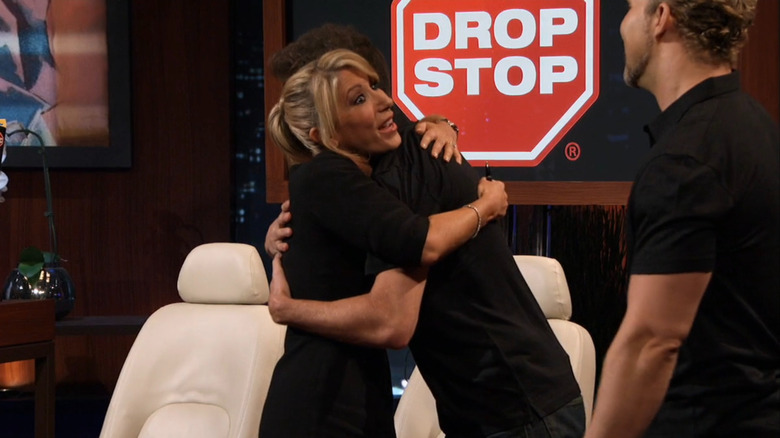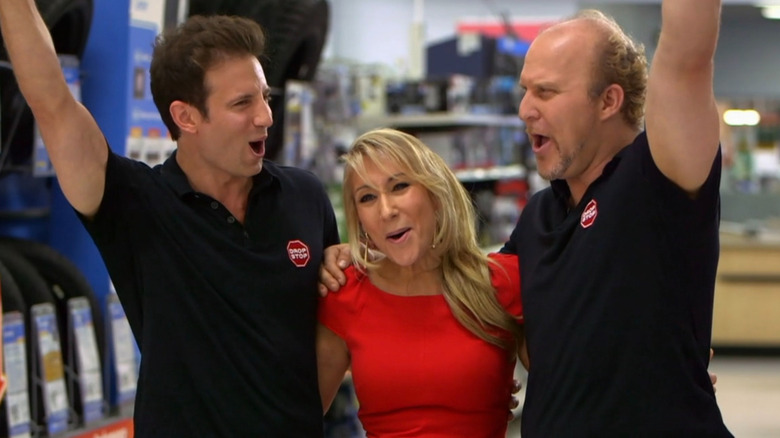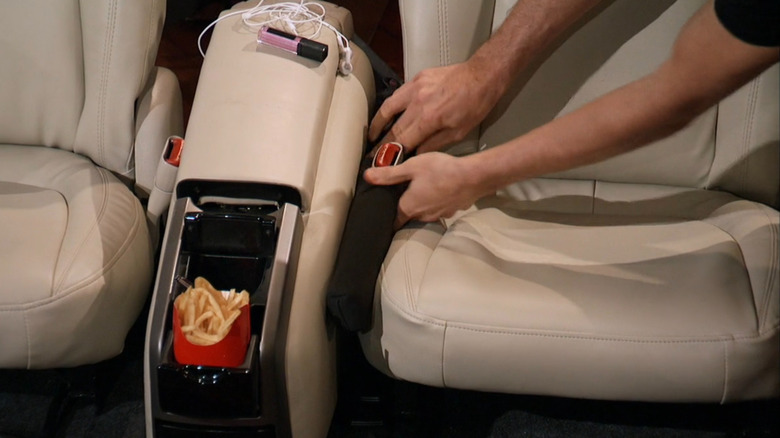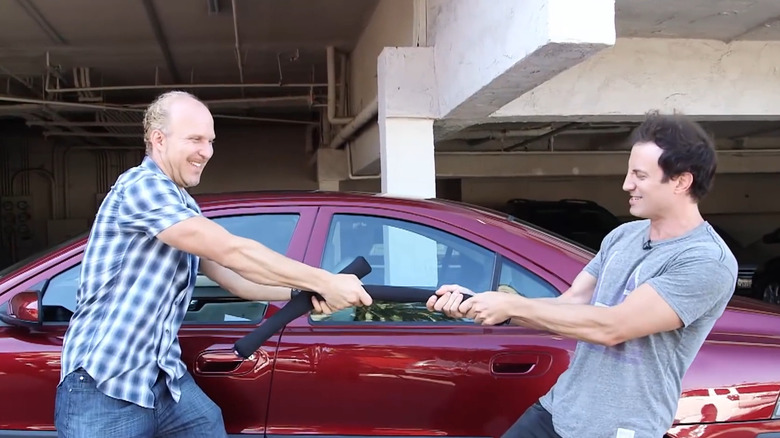What Happened To The Drop Stop From Shark Tank Season 4?
We may receive a commission on purchases made from links.
One seemingly minor detail that has been a major source of frustration to drivers everywhere for decades has been the accursed seat gap. While some may view this as little more than a minor inconvenience where french fries and pennies go to rest, a pair of entrepreneurs saw a more serious problem at hand that demanded a serious solution. The result was The Drop Stop, a fabric blockade made to fit into the gap and around your seat belt, halting anything from falling down the gap while potentially saving lives in the process.
This was the driving force behind The Drop Stop's creation. While driving around Los Angeles in 2006, co-founder Marc Newburger's phone fell down the seat gap. While attempting to reach it, his car swerved onto the sidewalk, nearly colliding with a pedestrian and a telephone pole. When he and his roommate, Jeffrey Simon, tried finding a product to fill in the seat gap, they were stunned to learn that no such solution existed and became motivated to make this a reality. After a lengthy period of designing prototypes, begging friends and family to invest, and fighting for patent approval, they began to receive significant attention, selling over $2 million worth of product and making 42 QVC appearances.
The duo made their "Shark Tank" debut on Season 4, Episode 20 of the hit ABC series. In it, their simple yet effective invention left a largely positive impression on the investors, leading to a tussle between Lori Greiner and Kevin O'Leary.
What Happened to The Drop Stop on Shark Tank?
Drop Stop co-founders Marc Newburger and Jeffrey Simon entered the tank with the intent of receiving $300,000 for a 15% equity stake in their company. Their initial presentation was met with some chuckles, but the laughter stopped when the duo shared that they had sold 260,000 units since launching the company in 2009. They were on track to hit $500,000 by the end of the year and net a profit of $260,000.
At this point, the Drop Stop was primarily being sold online, although their several QVC appearances also helped boost sales. Their economics were also sound, with a set of two Drop Stops costing $4 to produce and selling for $19.99. More importantly than solving an everyday dilemma, the duo believed that their product could save lives, mentioning Newburger's near-death experience and some troubling statistics from the Department of Transportation regarding distraction-related driving fatalities.
Robert Herjavec and Daymond John failed to see the value in the company and dropped out. Mark Cuban was more understanding and even said he'd be a customer, but felt he wasn't the right partner for their endeavor. Kevin O'Leary made the first offer, although rather than wanting equity, he cared more about getting his money back, proposing a $2 royalty for each unit sold that he would lower to $1 once he recoups his investment. Given her lofty reputation with QVC, Lori Greiner saw great potential in the product and asked to have an equity stake of 20%. After some deliberation, the duo went with Greiner.
The Drop Stop after Shark Tank
While Lori Greiner is known as a top-tier investor with numerous household name products in her portfolio, she's no stranger to dropping out of deals following the due diligence period that occurs after an episode's airing, such as Season 9's Bravo Tipping App and Season 14's Lavabox. Fortunately, this wasn't the case for The Drop Stop team, and it wouldn't take long for them to benefit from the queen of QVC's magic touch.
The Drop Stop segment had its initial airing on March 29, 2013, but it'd be far from the company's last appearance on the show. Later that same year, Drop Stop appeared on the Season 5, Episode 10 update segment. In the five months since their episode aired, the team was able to hire more people and had made $5 million in sales, with $15 million projected for the following year. Greiner opened the door to some major opportunities, including getting their product into 3,500 Walmarts and helping organize a donation of over 400 Drop Stops to the Los Angeles Police Department.
Their following "Tank" update segment on Season 9 saw this partnership pay off as the LAPD reported positive results from the use of Drop Stops and shared they'd be employing the devices in 3,000 of their vehicles. By this point, five years after making the deal, the founders shared that their company had brought in $28 million. Following this, in a Season 11 update segment where Greiner's many entrepreneurs came together to celebrate crossing $1 billion in retail sales, the Drop Stop team briefly appeared and announced that they were now at $40 million.
Is The Drop Stop still in business?
Whereas some early era "Shark Tank" products struggle to maintain their relevance over the years without major alterations to their brand, Drop Stop has managed to hold on to its success even over a decade following its time in the limelight. Even though a number of cheaper imitators have popped up, the power of "Shark Tank" alone has given Drop Stop a great deal of credibility.
Today, you can purchase the product at retailers such as Target and Amazon for $24.99, which will get you two Drop Stops along with a slide-free pad for phones and an LED credit card light for looking into dark crevices. On the latter site, along with being listed as a best-seller, it sports a stellar 4.6 out of 5-star rating average from nearly 70,000 buyers who largely praised its easy installation, clean fit, unassuming presence, and overall effectiveness. We even gave it a positive review in 2024, where it succeeded with flying colors during a five-hour family road trip that included kids, fast food, and snacks of all sorts. The only notable criticism brought up by some is that, while the Drop Stop fits into a majority of vehicles, a select few, such as the BMW M3 and VW Jetta, possess too narrow a space for the device to fit.
What's next for The Drop Stop?
When coming out to Los Angeles to work in the entertainment industry, it's unlikely that Marc Newburger or Jeffrey Simon ever expected to end up creating one of the most successful "Shark Tank" products out there. But it's safe to say that they haven't regretted their decision. By creating a simple product that solves a universal issue, Drop Stop has become a fruitful endeavor with endless appeal. Their story ultimately amplifies the core idea that "Shark Tank" celebrates — that, with the right vision and perseverance, even the most unlikely individual can rise to the occasion, make something great, and find success.
And that level of success has yet to wane. Thanks to its notable "Shark Tank" pitch, subsequent media appearances, and regular features and recommendations by outlets such as New York Magazine and E! News, Drop Stop continues to populate vehicles. In a 2024 interview with his former USC fraternity AEPi, Newburger shared, "Drop Stop just crossed the nine million mark (units sold) but there 14 million cars just in Los Angeles so we have a long way to go."
Despite a desire to continue growing the business, safety has always been the biggest driving force behind Newburger's ambitions, even if it compromises Drop Stop's future. "We're working on legislation that would mandate that auto makers would have to eliminate the gap," he continued. "It would put us out of business, but people are dying because we're in business." Whatever the outcome of these efforts, it's good to know that Newburger's vision goes beyond trying to make a quick buck.
